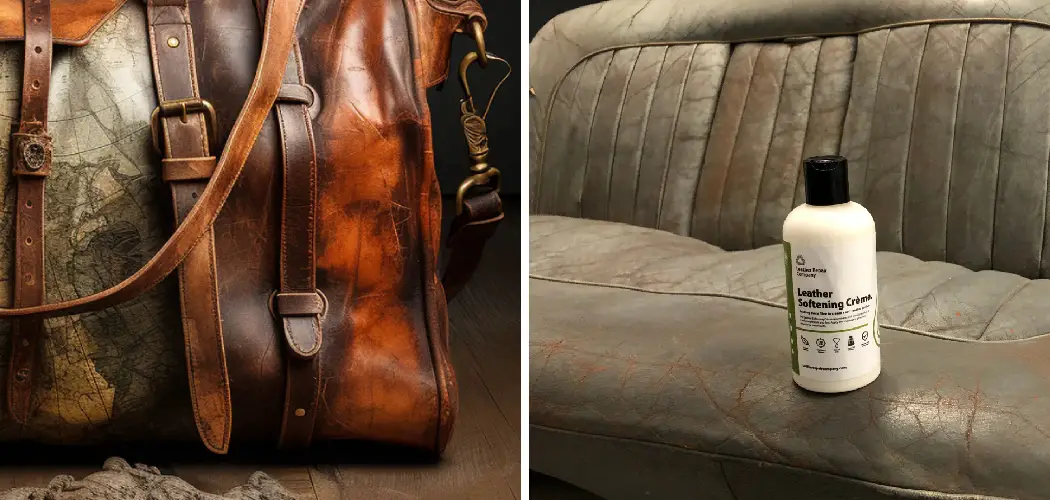Dry leather can be a common problem, especially for items like jackets, shoes, and furniture that are frequently exposed to the elements or constant use. Over time, leather can lose its natural oils, leading to cracks, stiffness, and overall deterioration. However, with proper care and reconditioning, you can restore dry leather to its former glory.
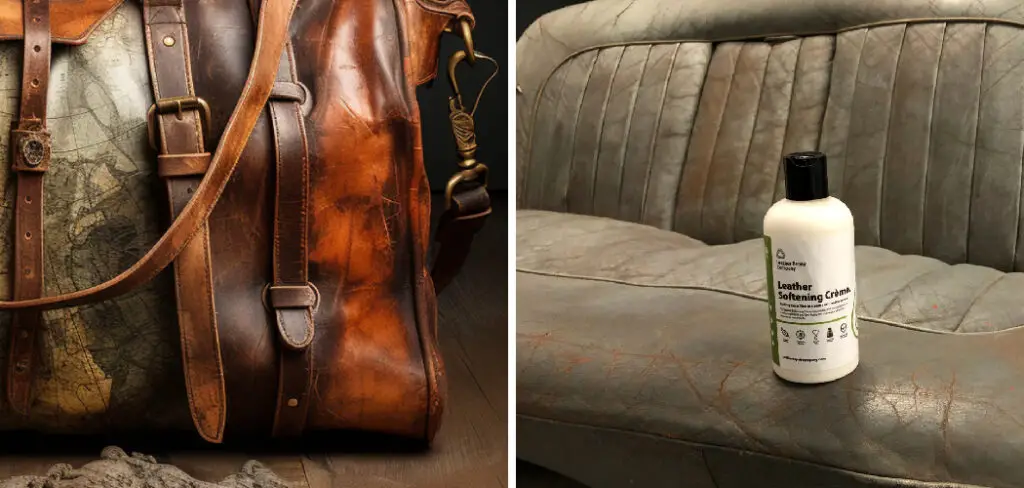
This guide on how to recondition dry leather will walk you through the essential steps and tips for effectively reconditioning dry leather, ensuring it remains supple, durable, and visually appealing for years to come.
What Causes Leather to Dry Out?
Before diving into the reconditioning process, it’s essential to understand the common causes of dry leather.
Exposure to sunlight and extreme temperatures can cause leather to dry out quickly, as it can frequently be used without proper care. Additionally, certain types of leather, such as aniline or suede, are prone to drying out faster than others.
You may also notice that leather items stored in dry environments, like attics or basements, are more likely to become dry and cracked. Mold and mildew can also cause damage to leather, especially if it’s not cleaned and dried properly after being exposed to moisture.
Now that you know some of the common culprits behind dry leather, let’s explore how to effectively recondition it.
Why Recondition Dry Leather?
Reconditioning dry leather not only restores its appearance but also extends its lifespan. When left untreated, dry leather can become brittle and prone to cracking, making it more susceptible to damage over time.
By reconditioning your leather regularly, you can prevent this from happening and keep your leather items looking and feeling like new for longer.
You may also find that reconditioning leather can save you money in the long run. Instead of constantly replacing dry and damaged leather items, taking the time to recondition them can help you avoid unnecessary expenses.
Necessary Tools and Materials
Before you begin the reconditioning process, make sure you have all the necessary tools and materials on hand. Here’s a list of what you’ll need:
Leather Cleaner:
Choose a gentle leather cleaner specifically designed to recondition dry leather. Avoid using harsh chemicals that can further dry out the leather or cause discoloration.
Soft Cloths:
You’ll need soft, lint-free cloths to apply the cleaner and conditioner to the leather.

Leather Conditioner:
Invest in a high-quality leather conditioner to restore moisture and suppleness to dry leather. Look for products that contain natural oils like lanolin, mink oil, or beeswax.
Leather Brush:
A soft-bristled brush can help remove any dirt or debris from the surface of the leather before reconditioning.
Gloves:
Wearing gloves while handling leather can prevent oils and dirt from transferring onto it from your hands.
10 Step-by-step Guidelines on How to Recondition Dry Leather
Step 1: Clean the Leather
Before reconditioning, start by cleaning the leather thoroughly to remove any dirt, dust, or residue that may have accumulated on the surface. Use a soft cloth or brush to gently wipe away any debris. You can also use a mild soap solution if your leather is particularly dirty. It’s essential to use a gentle cleaner to avoid further drying out the leather.
It’s best to work in small sections, ensuring you cover every inch of the leather. Once you’ve finished cleaning, let the leather dry completely.
Step 2: Test the Leather Cleaner and Conditioner
Before applying any cleaner or conditioner to the entire surface of your leather item, test it on a small, inconspicuous area first. This step can help ensure that there are no adverse effects or discoloration.
Once you’re satisfied with the results from the test patch, you can move on to treating the whole item.
Step 3: Apply Leather Conditioner
Using a clean cloth or sponge, apply a thin layer of leather conditioner onto the surface of the leather. Work in small sections at a time and make sure to cover every inch of the leather. If you’re working with a large item, like a couch or jacket, consider using a spray bottle for more coverage.
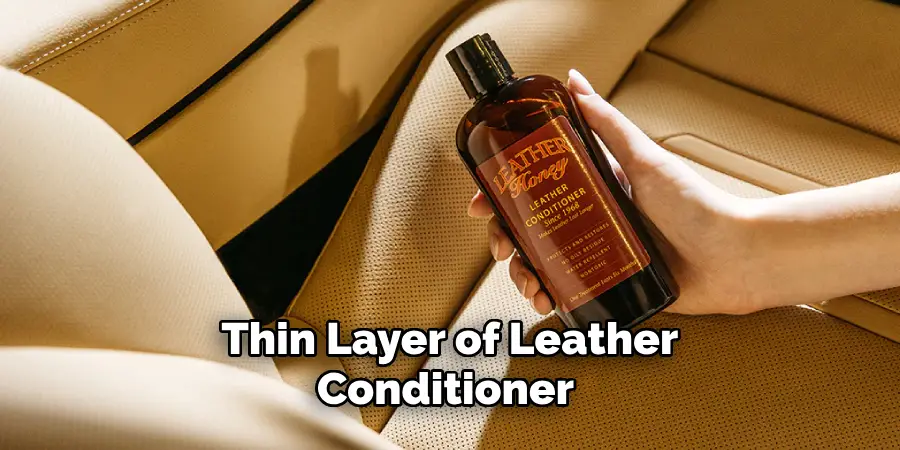
You may need to apply multiple layers of conditioner, depending on how dry the leather is. Allow each layer to absorb fully into the leather before applying another.
Step 4: Massage the Leather
Once the leather conditioner has been applied, it’s important to massage the conditioner into the leather.
Using your hands or a soft cloth, gently rub the conditioner in circular motions. This helps the leather absorb the conditioner more effectively and ensures that it penetrates deeper into the fibers. Take your time and focus on areas that feel particularly dry or stiff.
Massaging the leather not only helps with absorption but also improves its flexibility and softness. After you’ve thoroughly massaged the conditioner into the leather, allow it to sit and absorb for a few hours, or as recommended by the conditioner’s instructions.
Step 5: Wipe off the Excess Conditioner
After allowing the conditioner to absorb into the leather for the recommended amount of time, use a clean, dry cloth to gently wipe off any excess conditioner from the surface.
This step is crucial to prevent the leather from becoming sticky or greasy, which can attract dirt and dust. Make sure to use light, sweeping motions and focus on removing any residue that hasn’t been absorbed by the leather.
By removing the excess conditioner, you’ll help maintain the leather’s smooth texture and natural sheen, ensuring that it remains both visually appealing and pleasant to the touch. Once you’ve wiped off the excess, allow the leather to rest and fully absorb the treatment before using or storing the item.
Step 6: Buff the Leather
After wiping off the excess conditioner and allowing it to absorb, you can use a soft cloth to buff the leather gently. This step helps enhance the shine of your leather item and gives it a polished finish. Make sure to use light, circular motions and avoid pressing too hard on the surface.
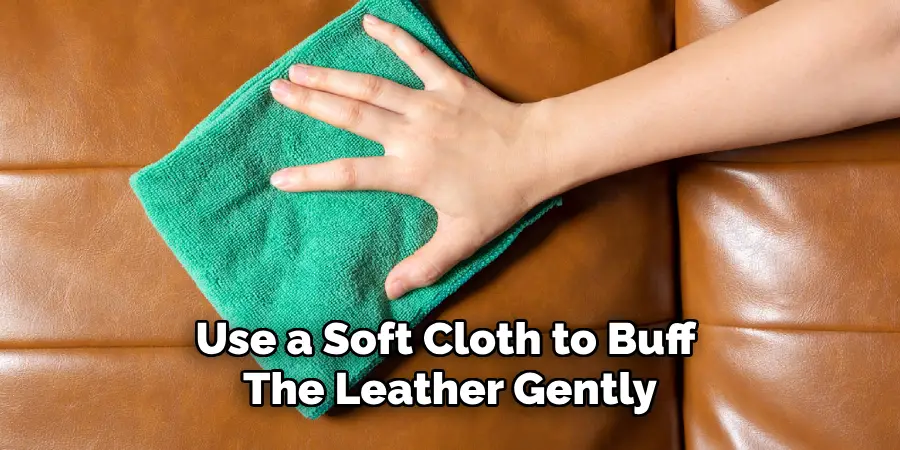
Buffing also helps distribute any remaining conditioner evenly and removes any visible streaks or residue from the treatment once you’re satisfied with how your leather looks, allow it to rest for a few more hours before using or storing.
Step 7: Repeat as Needed
If your leather item is particularly dry or damaged, you may need to repeat this reconditioning process multiple times until you achieve the desired results. It’s essential to be patient and take your time with each application, as rushing through the process can result in uneven treatment or damage to the leather.
Once you’ve achieved the desired level of reconditioning, you can continue to maintain your leather regularly using this process.
Step 8: Store Properly
After reconditioning your leather, it’s vital to store it correctly to prevent any further damage or drying out. Avoid placing leather items in direct sunlight or near sources of heat, which can cause fading and cracking.
Instead, store them in a cool, dry place away from any potential hazards. If storing clothing items like jackets or shoes, make sure they are hanging instead of folded to avoid creases and damage.
You can also use dust covers or tissue paper to protect your leather items from dust and dirt while in storage.
Step 9: Avoid Harsh Chemicals
When reconditioning or cleaning leather, it’s crucial to avoid using any harsh chemicals that could damage the material. Stick to gentle cleansers and conditioners formulated specifically for leather.
Avoid using products with alcohol, ammonia, or bleach, as these can strip away the natural oils and cause the leather to dry out further.
Step 10: Regular Maintenance
To prevent your leather from becoming excessively dry or damaged in the future, it’s essential to perform regular maintenance on your items. This includes wiping off any spills or stains immediately, keeping them away from direct sunlight and heat sources, and regularly cleaning and conditioning them.
By following these steps on how to recondition dry leather and maintain your leather properly, you can ensure that it remains in top condition for years to come. Enjoy the durability, beauty, and luxurious feel of genuine leather by taking care of it with the right products and techniques.
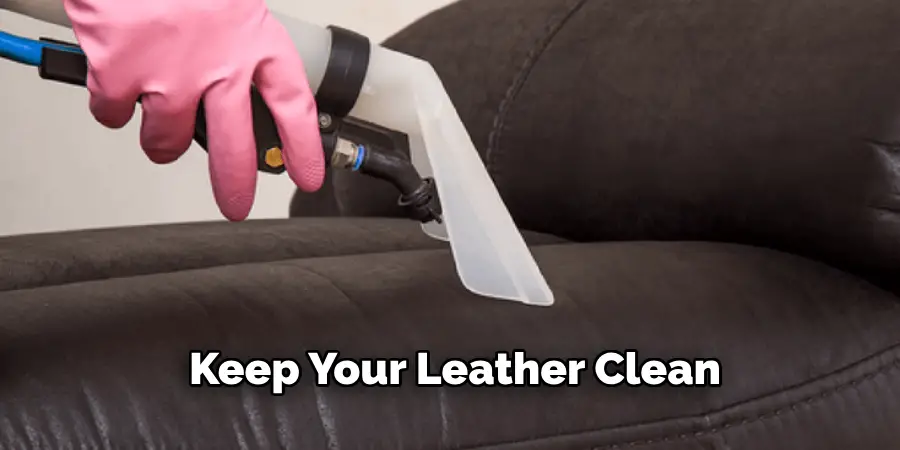
So go ahead and and invest in quality leather items,, knowing that you have the knowledge to keep them looking their best for a long time! Keep your leather clean, conditioned, and well-maintained, and it will reward you with timeless elegance and style. Happy reconditioning!
Maintenance
Regular maintenance is the key to preserving the quality and appearance of your leather items. By adhering to a consistent care routine, you can avoid premature wear and damage. Here are some essential maintenance tips:
Cleaning
Wipe down your leather items regularly with a soft, dry cloth to remove dust and debris. For deeper cleaning, use a damp cloth and a mild leather cleaner, ensuring you follow the product instructions. Always test any cleaner on a small, inconspicuous area first to avoid discoloration or damage.
Conditioning
Condition your leather items every 3-6 months, or more frequently if you live in a dry climate or use the items heavily. Apply a high-quality leather conditioner using a clean cloth, and ensure even distribution across the surface. Let the leather absorb the conditioner fully before buffing it to a shine.
Storage
Store leather items in a cool, dry place away from direct sunlight and heat sources that can cause fading and cracking. Use dust covers for clothes and tissue stuffing for shoes to maintain their shape and protect from dust.
Protection
Protect your leather from spills and stains by treating it with water and stain-repellent designed for leather. Address any stains immediately by blotting them with a clean, dry cloth and avoiding the use of excess water.
Usage
Rotate the use of leather items, such as shoes and bags, to ensure even wear. Avoid overloading bags and properly support the shape of garments on padded hangers or with tissue paper.
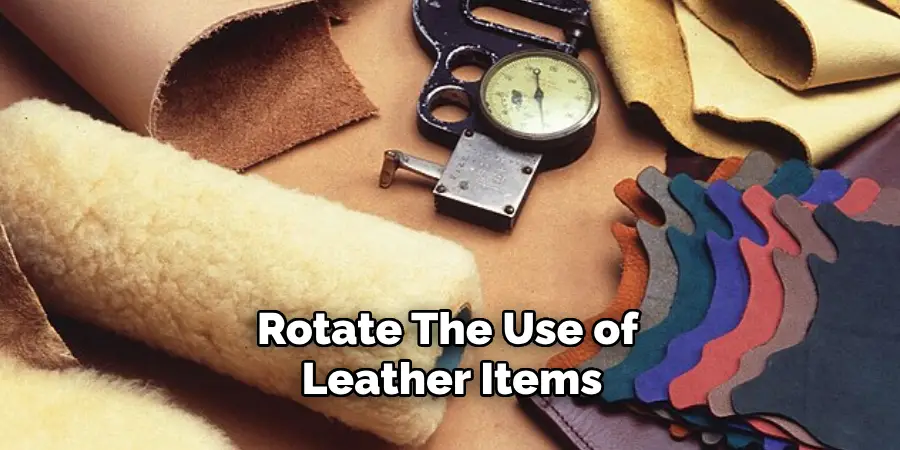
By following these maintenance tips, you can extend the lifespan of your leather items, ensuring they remain as beautiful and functional as the day you first acquired them. Remember, the key to great-looking leather is consistent, gentle care.
Additional Tips
Avoiding Over-Moisturization
While conditioning your leather is crucial, over-moisturizing can lead to a greasy surface and attract more dust. Stick to a recommended schedule and adjust based on the climate and usage.
Using Professional Services
For deeply soiled or severely damaged leather, consider professional cleaning and repair services. They have specialized tools and products to handle tough stains and restore leather to its original state.
Natural Solutions
If you’re inclined towards natural products, consider using beeswax-based conditioners. These are eco-friendly and provide an excellent protective layer, maintaining the leather’s suppleness and durability.
Sunlight Exposure
If your leather item has been exposed to sunlight for an extended period, you might notice some fading. To restore the color, apply a leather dye that matches the original color. Always test it in an inconspicuous area first.
Winter Care
In winter, salt and snow can damage leather, especially shoes and boots. Wipe down your items as soon as you come indoors and apply a waterproofing product to protect them from moisture.
Investing in Quality
Not all leather care products are created equal. Investing in high-quality cleaners and conditioners can make a significant difference in the longevity and appearance of your leather goods.
By incorporating these additional tips into your leather care routine, you can further ensure that your items remain in pristine condition for years to come. Proper care not only maintains the aesthetic and functional qualities of leather but also safeguards your investment.
Avoid Overstuffing
Overstuffing leather bags, wallets, and shoes can lead to stretching and deformation, compromising the shape and structural integrity of the item. Always ensure your leather goods are filled to a reasonable capacity and avoid cramming them with too many items.
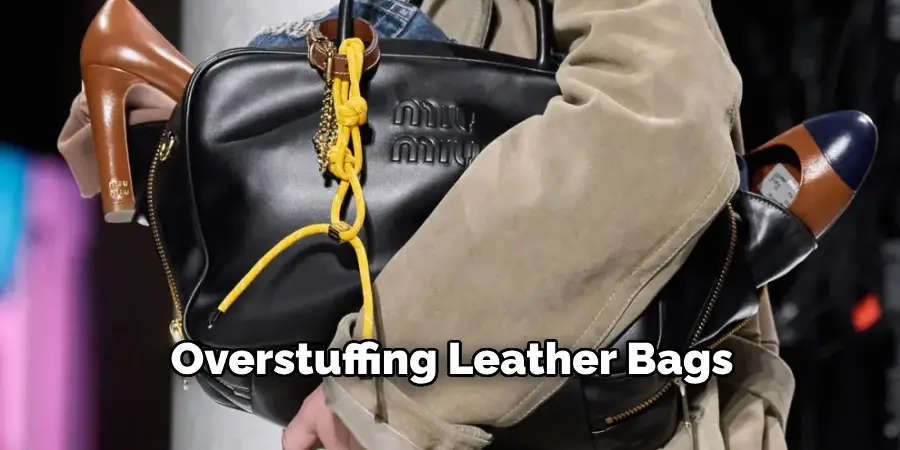
Handling Wet Leather
If your leather item gets soaked, never use direct heat to dry it, as this can cause the leather to become stiff and brittle. Instead, pat it gently with a dry cloth to remove excess water and allow it to air dry naturally in a cool, ventilated area.
Preventing Odors
Leather can absorb smells from the environment and from usage. To keep your leather items smelling fresh, use natural deodorizing methods such as placing a sachet of baking soda or activated charcoal inside the item when not in use.
Mindful Handling
Frequent handling can transfer oils from your skin to the leather, which over time can cause discoloration. Make sure to handle your leather goods with clean hands, and periodically wipe them down to remove any transferred oils or residues.
Seasonal Swaps
Rotating your leather items with the change of seasons can help extend their life. Switch out heavier winter leather wear with lighter options in the spring and summer, ensuring each item has a break and isn’t subject to continuous wear and tear year-round.
Incorporating these additional tips into your leather care regimen can greatly enhance the longevity and appearance of your leather items. With attentive maintenance and a few precautionary measures, your leather goods can continue to look immaculate and serve you well for many years.
Frequently Asked Questions
Q: Can I Use Household Cleaners to Recondition My Leather?
A: No, it’s best to stick with gentle cleaners and conditioners specifically formulated for leather. Harsh chemicals found in household cleaners can damage the leather and cause it to dry out further.
Q: How Often Should I Recondition My Leather?
A: This depends on how often you use your leather items and their exposure to environmental factors. Generally, reconditioning every 6-12 months is recommended for regular maintenance.
However, if your leather has become excessively dry or damaged, you may need to recondition it more frequently until you achieve the desired results.
Q: Can I Use a Hairdryer to Speed Up the Absorption of the Conditioner?
A: No, it’s not recommended as the heat from the hairdryer can cause damage to the leather. It’s best to allow the conditioner to absorb naturally and take its time to penetrate the fibers.

Q: Can I Recondition Colored Leather?
A: Yes, you can recondition colored leather using the same steps mentioned above. However, be sure to test a small, inconspicuous area first to ensure that the conditioner does not cause any discoloration or damage. If in doubt, it’s best to consult a professional leather cleaner for advice.
Conclusion
By following these comprehensive care tips on how to recondition dry leather, you can preserve the beauty and functionality of your leather items for many years. Consistent maintenance, mindful handling, and the use of appropriate products play crucial roles in extending the lifespan of leather.
Remember that investing in high-quality leather goods is only half the battle; the other half lies in the diligent care and attention you give them. With proper upkeep, your leather items can remain timeless pieces that continue to look elegant and serve their purpose effectively.

